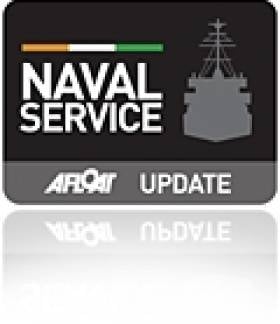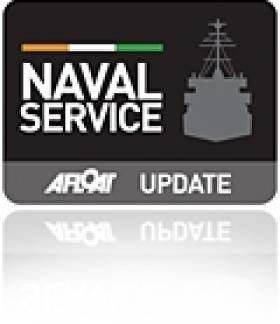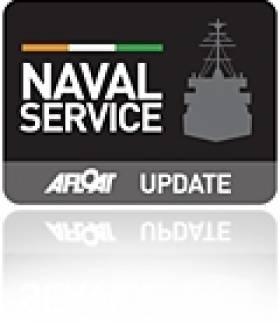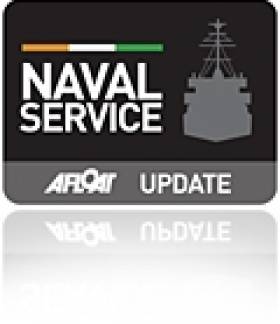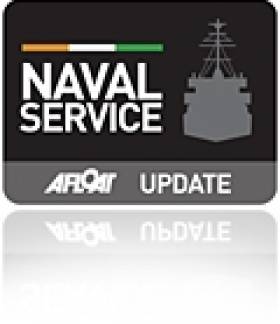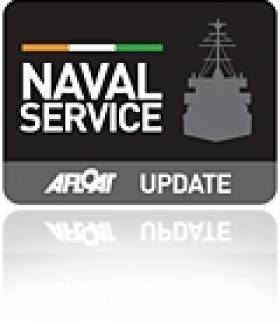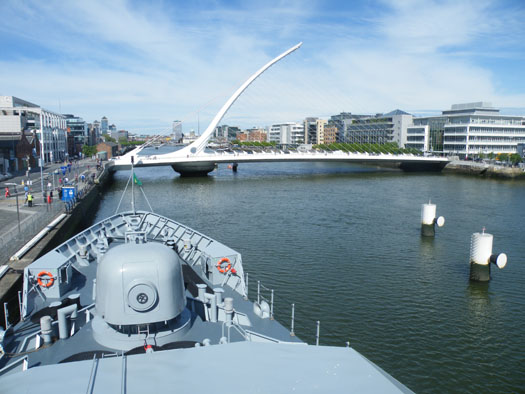Displaying items by tag: Navy
Naval Service Exercise Demonstrates Multi-Task Roles for Newest and Oldest Patrol Vessels
#NavalExercises – The Naval Service's newest and oldest patrol vessels have taken part in a week-long major exercise, one of several held annually, where L.É Samuel Beckett (P61) set her paces accompanied by L.E. Aoife offshore of Cork Harbour, writes Jehan Ashmore.
In command of the €54m newbuild is Cdr. Ken Minihan who recently was promoted to the role of Officer in Charge of Fleet Operations, in which he will take this position in August. Cdr. Minihan has the responsibility of 43 crew and on occasions this can rise by a further 10 personnel.
Due to the overall requirements to recruit crew and that of the newbuild programme of a trio of OPV90 or 'Beckett' class, the new ships will feature additional berths to accommodate 10 cadet trainees.
According to Cdr. Minihan, the OPV has better sea-keeping characteristics compared to her predecessors and the ability to maintain 9 knots in a 'Power Take In' mode as 2 x Wartsila diesel engines can generate otherwise a maximum of 23 knots.
The OPV90 class are fitted with a 76mm OTO Melara the main armoury mounted on the bow of the newbuilds which are to replace an ageing pair of 'Emer' class sisters. L.E. Aoife is understood to decomission by the end of the year. She will be replaced by the delivery of L.E. James James in the first quater of 2015 and followed by the final newbuild due in 2016.
One of the trainees taking ship-time experience on board L.E. Samual Beckett is Ger Fannin from Clare who at 29 years is one of the oldest students to have entered the cadetship. Along with his colleagues they will attend a commissioning into service ceremony in September.
This was only the second time that Fannin has been at sea where the cadet expressed how proud he was to be on the new 2,226 tonnes offshore patrol vessel, which is ending her first patrol today since commissioning just over a month ago in Dublin.
In the last six years the Naval Service has intercepted €1.7 Billion worth of drugs in Irish waters and the importance of carrying out such exercises (in a real-scenario they are carried out at night), is where the boarding teams are also equipped with night-vision capabilities.
This is where the role of Maritime Interdiction Operations as previously reported saw armed counter-narcotics Naval Teams set off from L.E. Samuel Beckett. The interdiction teams used a pair of high-speed RIBS capable of twice the speed of the 'mother' vessel, as they can reach up to 40 knots. The teams set a course to the L.E. Aoife which acted as the 'suspect' vessel.
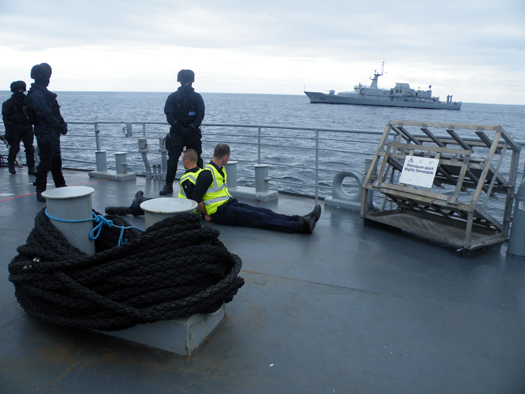
Interdiction party on the aft–deck
Completely dressed in black uniforms including helmets, the teams armed with pistols and truncheons boarded the L.E. Aoife. Two of her crew-members acted as individuals engaged in criminal activity and where led under tight security up to the wheelhouse.
In addition to this high-drama scenario at sea, a casualty winching exercise with an Air Corps AW139 helicopter was carried out at close quarters above the aft-deck of L.E. Samuel Beckett. The helicopter normally based at Baldonnel had flown down to Cork Airport and onward to take part in the exercise.
Also part of the week's exercise where inter-ship replenishments for the transfer of personnel and provisions while naval ships are at sea. This alleviates the necessity for a ship to return to port while on domestic operations and potentially in circumstances where vessels could be deployed on missions overseas.
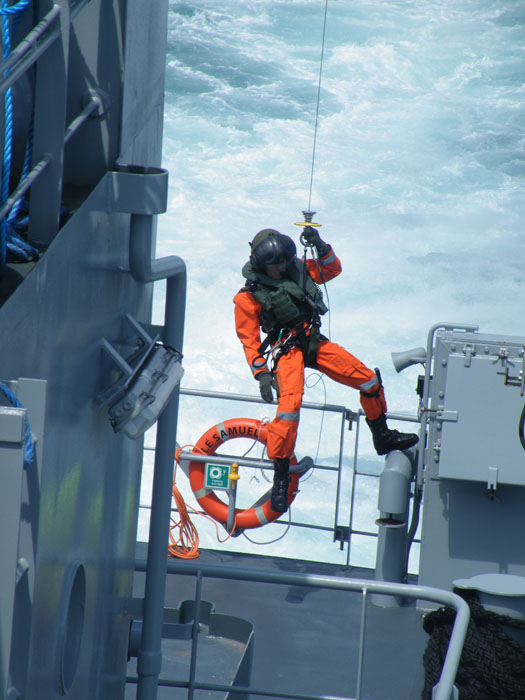
Winch operation
As outlined above the role of the Naval Service is clearly not just about fishery protection duties, in which there has been 407 boardings and four detentions carried out so far this year.
With the L.E. Samuel Beckett in service, the navy and that of her newbuild sisters are better prepared through new operational capability to undertake routine patrols and tasks in an area twelve times the size of Ireland's land mass.
An added efficiency to operations will be Unmanned Aerial Vehicles (UAV) which are planned to be introduced next year. This component in the Naval Service is to enhance in carrying out surveillance operations, among them covert vessel tracking to those dealing with oil-pollution monitoring.
A large area of EU waters (15%) is under Irish sovereign control and are patrolled by the Naval Service current fleet of 8 vessels. Our waters provide an estimated €3.4 billion in resources to the Irish exchequer annually or approximately equate to 1.2% of GDP.
Naval Service Fleet Exercise is Opportunity to Hone Skills
#defenceforces – Yesterday's Naval Service fleet exercises were an opportunity to hone skills and improve on techniques to ensure that the ships can respond to any operational requirement that they may be required to undertake in Ireland's extensive maritime domain, which covers an area twelve times the size of Ireland's land mass. The Naval Service patrols 15% of EU waters which are under Irish sovereign control and which provide an estimated €3.4 Billion in resources to the Irish exchequer annually or approx 1.2% of GDP.
New OPV L.E. Samuel Beckett to take Part in Major Naval Service Exercise Off the South Coast
#SamuelBeckett – The €53m newbuild OPV L.É Samuel Beckett (P61) along with L.É. Aoife (P22) will be conducting major exercises today off the south coast as part of a week-long fleet assessment by the Naval Service.
Some of the tasks involved include a scenario-based Maritime Interdiction Operation which prepares armed Naval Teams for counter-narcotics and armed boarding's at sea plus a casualty winching exercises with the Air Corps' AW139 helicopter.
In the last six years the Naval Service has intercepted €1.7 Billion worth of drugs in Irish waters. On fishery protection duties, the Naval Service has carried out 407 boardings and 4 detentions so far this year.
Inter-ship replenishment will also be exercised, for the transfer of personnel and provisions while naval ships are at sea. This alleviates the necessity for a ship to return to port while on operations.
Flag Officer Commanding Naval Service, Commodore Hugh Tully stated that: "As the State's principal seagoing agency, it is essential that Naval Units can respond quickly and effectively to any operational requirement that they may be called upon to provide in our area of operation, the North Atlantic, and at short notice. The men and women in the Naval Service operate in some of the most hostile seas in the world throughout the year. Our Annual Fleet Exercises provides an opportunity for Naval Service Units to hone their skills and for senior command to assess their operational capability."
An Taoiseach Confirms €54m Order for Third Offshore Patrol Vessel for the Naval Service
#navy – An Taoiseach and Minister for Defence Mr. Enda Kenny, T.D. announced this morning that an order has been placed with Babcock Marine for the 3rd Offshore Patrol Vessel for the Naval Service.
A vessel replacement strategy for the Naval Service has been in progress since 2007 to provide for the replacement of existing vessels some of which are over 30 years old. Following completion of a tender competition, Babcock Marine was selected for the purchase of two Offshore Patrol Vessels (OPVs) with an option on a third.
An Taoiseach said that "I recently attended the commissioning ceremony of LE Samuel Beckett, which brought home to me the necessity to continue with the vessel replacement strategy. The new ship is impressive and offers excellent value and I am convinced that this is the right time to maintain the momentum with the replacement strategy and move forward with a placing of a contract for the third Patrol Vessel."
By taking up the option under the existing contract, the Department secures that the third ship will be bought on 2012 prices and will not be index linked thus ensuring that the vessel replacement programme is conducted in the most cost effective manner. In addition the Department secures that the fleet continues to be modernised with the added advantage of standardising the fleet. If a new procurement exercise was to be initiated it could take over 5 years to complete the procurement process with no guarantee that a new ship would be of the same design.
Following discussions with Babcock Marine, it has been agreed to place an order for the third ship at a price of €54m. The new Ship will be identical in build to the recently commissioned LE Samuel Beckett and the currently under construction LE James Joyce.
An Taoiseach concluded by saying "the Naval Service carries out a wide range of challenging roles. Naval Service ships assert the integrity of our territorial waters as well as protecting the marine resources of the country. The Naval Service's operational capacity in a highly demanding environment will be enhanced when the three new Offshore Vessels are in service".
The third Vessel will be delivered in 2016.
#SamuelBeckett - The State's newest Naval Service patrol vessel opened to the public for the first time (in Cork), and there to greet the arrival was a little girl who welcomed her father home from sea yesterday, writes the Irish Examiner.
Allie O'Connell, 12, from Ballyvolane, gave her father, CPO Phil O'Connell, a huge hug as he stepped off the state-of-the-art LÉ Samuel Beckett, shortly after arriving at Cork's city quays yesterday ahead of its formal twinning ceremony with the city later today.
"It was great to see her," the vessel's coxswain said. "We are in the middle of a four-week patrol and it was great to come up the river and to be welcomed by her. My mother, Bridie, was there too."
Allie and her classmates from Scoil Oilibhéir were due to form a guard of honour on the quayside as part of the twinning ceremonies later today.
For more including footage of her crew boarding the new OPV in Dublin's central quays where as previously reported on Afloat.ie, the €50m OPV was named and commissioned into service in a joint ceremony held last month. Afterwards, the newbuild was opened for the first time ever to the public.
#SamuelBeckett - The state's newest naval vessel, the €50m LÉ Samuel Beckett (P61), is to be twinned with Cork City, homeport of the Irish Naval Service, reports The Irish Examiner.
A Naval Service spokesman confirmed the vessel, which boasts Star Wars-style 'drone' technology, as previously reported on Afloat.ie, will sail from the naval base in Haulbowline up to the city quays for the formal twinning ceremonies.
Final arrangements are still being put in place — the twinning ceremony will likely take place on June 7, with plans to open the ship for public tours on June 8. For more on this, click here.
As previously reported on Afloat.ie last year, there was speculation surrounding the newbuild OPV's twinning with Cork City and the confirmation aptly follows that of her predecessor, the former L.E. Emer whose adopted 'homeport' was also of the rebel city.
Asides the Naval Service historic use of drones or "unmanned aerial surveillance vehicles", the 'Beckett' class will also feature state-of-the-art technology among them robotic submersibles.
#SamuelBeckett – As the sleek profile of Naval Service newbuild OPV L.E. Samuel Beckett (P61) got underway yesterday on the horizon off Killiney Bay (see photo at bottom this link) this was her first patrol since Saturday's joint naming and commissioning ceremony in Dublin, writes Jehan Ashmore.
At almost 90m long the Babcock Marine built OPV90 class L.E. Samuel Beckett is 12 metres longer than her predecessor the OPV80 class leadship 'Roisin'. She was followed by sister, L.E. Niamh in 2001, having also been built at the north Devon shipyard then managed by Appledore Shipbuilders.
The hull forms of the Beckett class and her sister L.E. James Joyce currently under construction are designed by STX Marine. The improved sea-keeping qualities of the hull (see link to Air Corps footage off Ballycotton and Dublin Bay) are not only to improve operational working conditions.
The increased length and aft-deck space provides for storage of containers for (potential UN mandated) missions requiring humanitarian supplies and equipment. As such the newbuild can carry more than the 'Roisin' class sisters. Another benefit of the longer hull is that of crew comfort, particularly during the harsh environment of the Atlantic.
Having left an overcast Dublin Bay and in considerably calmer seas she increased speed passsing Dalkey Island and as seen on the photograph on the horizon off Killiney Bay. This resulted in greater resistance as the bow wave increased at the flared bow designed to deflect water away and minimise impact on the hull while maximising speed and fuel efficiency.
She can achieve a maimum of 23 Knots which is generated from a pair of Wartsila diesel engines (10,000kw) which drive through twin shafts and propellers.
The newbuild has an endurance range of 6,000 nautical miles which will be required given that Ireland has a Fishey Exclusive Protection zone to patrol in an area representing 16% of EU waters. The OPV's main armament is a 76mm OTO Melara compact gun mounted at the bow.
As for that yellow buoy... in the photo, this is one of three marking a safety zone for bathers along a stretch of Killiney Beach close to Dalkey's White Rock Beach. They are there to protect bathers under a beach by-law implemented several years ago by Dun Laoghaire-Rathdown County Council.
Boating activity among marine leisure users, notably jet-skiers, are not permitted to transit the zone between the buoys and the beach in the interest of safety for swimmers.
#navy – More great footage from the Irish Air Corps on the Navy's newest ship, LE Samuel Beckett during her recent run up prior to commissioning.
As Afloat reported previously An Taoiseach and Minister for Defence Mr. Enda Kenny, T.D. attended the naming and commissioning ceremonies for the new Naval Service ship, LÉ Samuel Beckett beside the Samuel Beckett Bridge in Dublin city centre. The naming ceremony was carried out by a niece of Samuel Beckett, Mrs. Caroline Murphy. The second ship, James Joyce is to arrive in 2015..
The LÉ Samuel Beckett did some 'interoperability' training with the Air Corps. Airman Terry Healy captured some great footage of Ireland's latest vessel being put through her paces off the south coast and then coming into Dublin on the 16th May for the first time.
RTE Nationwide broadcasts a half hour special on the LE Samuel Beckett this evening (Monday 19th) at 7pm on RTE One.
#navy – Following a tender competition the first of two new ships for the Irish Navy arrived into Dublin for a naming ceremony at the weekend. See time lapse arrival of her arrival up the River Liffey above. As Afloat reported previously An Taoiseach and Minister for Defence Mr. Enda Kenny, T.D. attended the naming and commissioning ceremonies for the new Naval Service ship, LÉ Samuel Beckett beside the Samuel Beckett Bridge in Dublin city centre. The naming ceremony was carried out by a niece of Samuel Beckett, Mrs. Caroline Murphy. The second ship, James Joyce is to arrive in 2015.
The contract for the new ships was signed in October 2010, with Babcock Marine, part of the Babcock International Group, in the United Kingdom for the provision of two new offshore Patrol Vessels (OPVs) for the Naval Service to be built in Appledore, Devon, United Kingdom (same shipyard where both LÉ Roisin and LÉ. Niamh were built over a decade ago).
The new ships are larger vessels than LÉ Roisin and LÉ Niamh with a length of 89.5m.The cost of the two new ships is €108m, exclusive of VAT.
This is a replacement programme – LÉ Samuel Beckett replaces LÉ Emer which was decommissioned and sold late last year. The ship will be used mainly for fishery protection patrols.
LÉ Samuel Beckett arrived home to the Naval Base, Haulbowline, Cork on Wednesday 30th April 2014. The ships first captain is Commander Ken Minehane from Bantry. The ship will have a main crew of 44.
Work on the second ship (LÉ James Joyce) is well advanced and it should be completed early in 2015. LÉ James Joyce will replace LÉ Aoife.
Brief Specification of the LE Samuel Beckett
|
Class of Ship |
Offshore Patrol Vessel |
|
Length |
89.5 metres |
|
Beam |
14 metres |
|
Draft |
3.8 metres |
|
Max Speed |
23 knots |
|
Propulsion |
2 x Wartsila Diesel Engines, 2 shafts, 10000kw |
|
Accommodation |
44 crew plus 10 trainees |
|
Main Weapons |
1 x 76mm Oto Melara Compact Naval Gun 2 x 20mm RH 202 Rheinmetall Cannon 2 x 12.7mm Heavy Machine Gun’s 4 x 7.62mm General Purpose Machine Gun’s
|
#SamuelBeckett- A niece of Samuel Beckett, Caroline Murphy performed the honour of naming the Naval Service's newest OPV, L.É. Samuel Beckett (P61) and at her side An Taoiseach and Minister for Defence Enda Kenny witnessed the customary champagne bottle smash against the bow, writes Jehan Ashmore.
In his address, An Taoiseach said "the naming and commissioning carried with it a great sense of pride and anticipation for all Naval Service personnel. L.E. Samuel Beckett will be a tremendous asset to the Naval Service. I know that the ship's first captain, Commander Ken Minehane and his crew are eagerly looking forward to working up the new ship to its full potential".
The €50m L.E. Samuel Beckett named after the Nobel Prize winning playright, took place along Sir John Rogerson's Quay. Also on the quayside is the statue of the founding father of the Argentine Navy, Admiral William Brown who hailed from Foxford, Co. Mayo. Ahead of the L.E. Samuel Beckett's bow is the Liffey bridge that also bears the same name of the playright.
The appropriate backdrop to the historic occasion included the commissioning of the OPV90 class newbuild into the Naval Service which took place in front of an invited audience as well as the public during glorious conditions.
Among the Government representives was the newly appointed Minister for Justice and officials from shipbuilders, Babcock Marine & Technology, Appledore in north Devon, which floated out the newbuild last November and saw her completed last month as yard no. 194.
The vessel which docked yesterday (see photos), was blessed and following this the L.E. Samuel Beckett's captain, Commander Ken Minehan read out the commissioning warrant to the ship's coy. Then the captain was 'piped' on board the vessel that was officially accepted as a state ship.
L.E. Samuel Beckett – the view from one bridge to another!

Captain Ken Minehan is 'piped' on board
The gangway also saw the ships company (off 44 personnel and 10 more for trainees) embark on the newest member of the Naval Service which has restored an eight-strong fleet follwing the decommissioning of L.E. Emer last year.
A sister of the newbuild, L.E. James Joyce (P62) which is constructed of 55 modular sections before been assembled is due to enter service next year. Together the 'Beckett' class cost €108m and among their primary roles are fishery protection, SAR, drug interdiction and monitoring of pollution incidents. Her main armement is the bow-mounted 76mm OTO Melara gun.
On board L.E. Samuel Beckett is an iconic photograph of the ship's namesake taken at Le Petit Café, Paris, in December 1985. This was Beckett's favourite place to meet his friends. The photographer, John Minihan was also on board to discuss the famous photograph with An Taoiseach, Captain Minehan and Caroline Murphy.
The other branches of the Defence Forces attended the ceremony, the Irish Army and Air Corps which provided a fly-past that tracked above the Liffey quays and involved a CASA Maritime Fisheries Patrol aircraft.
As guests explored the new vessel, the Army No. 1 Band played Adele's soundtrack to the James Bond film 'Skyfall' which all added to the celebratory atmosphere. Tomorrow (Sunday) afternoon, the newbuild will be open to the public between 2 and 5pm.
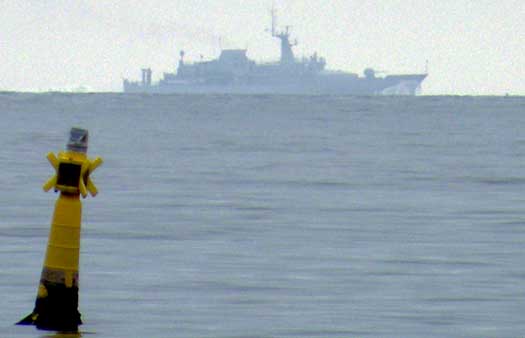
L.E. Samuel Beckett on first patrol after naming ceremony and is seen here off Killiney Bay





























